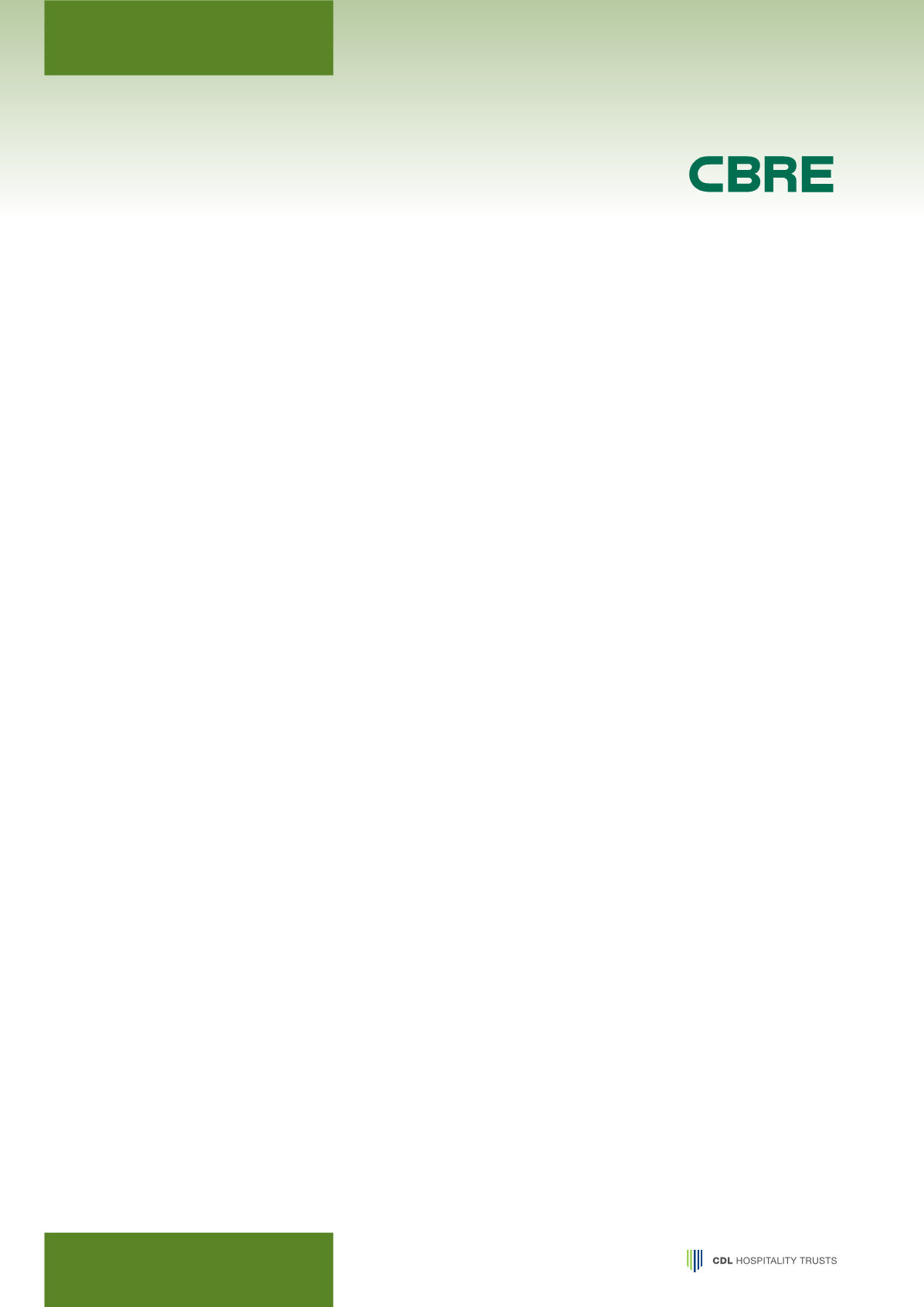
MARKET REVIEW
BRISBANE, AUSTRALIA
HOTEL PROPERTY SECTOR
BRISBANE TOURISM MARKET
In the 2014/15 financial year there were 1,066,121
international visitors to Brisbane, equating to approximately
16% of total international visitors to the Brisbane region,
who spent 23,060,625 visitor nights in the region. Major
source markets include Other Asia (Burma, Cambodia,
Laos, Vietnam, Philippines, Brunei, East Timor, Macau,
Mongolia, Bangladesh, Bhutan, Nepal, Pakistan, Sri Lanka,
Afghanistan, Georgia and Kazakhstan), New Zealand, China,
Europe and the United Kingdom. The average length of
stay by international visitors remains in excess of 22 nights.
A major contributor to this growth came from working
holiday visitors.
In the same period, Brisbane attracted 28% of the domestic
visitors to Queensland, equating to 5,412,989 annual visits
and 17,311,604 visitor nights. Visiting friends and relatives
(VFR), holiday and business all major reasons for travel to
the region.
HOTEL MARKET PERFORMANCE
Analysing the 10-year period from 2003/04 to 2013/14,
room nights available in the Brisbane Tourism Region have
grown by 34.4% and room nights occupied have increased
by 31.6% or an average of 3.4% per annum. The result
has been a decrease in occupancy from 73.5% to 72.0%.
Over this period there has been a significant increase
in Serviced Apartments which have increased by an
average of 8.5% per annum from 25% to now 38% of the
combined market.
TheBrisbanemarket is dependent toa largeextent uponboth
intra and interstate corporate travellers. Corporate travel
increased over recent years due to continued population
growth and economic activity, including the contributions
made by the infrastructure and mining development cycles.
Corporate demand eased in 2009 but strengthened again in
2010 and 2011 as business confidence improved; however,
demand slowed during 2012 and has contracted over
the past 3 years. Leisure demand for rooms is generally
short-term and dominated by the domestic segment during
non-peak periods. 2009 saw a competitive environment
for this market resulting in reduced room nights. Demand,
however, appears to have recovered from 2010 and 2011,
which was also impacted by the floods in Brisbane.
The MICE segment provides a significant contribution to the
Brisbane market. The Brisbane Convention Centre is readily
accessible from hotels within the CBD and surrounding
suburbs, and Brisbane is perceived as a safe and competitive
destination. A A$140 million expansion of the Brisbane
Convention and Exhibition Centre, adjacent to the existing
centre, opened in early 2012. Two additional facilities were
completed in 2013 including the A$59 million transformation
of the Industrial Pavilion at the RNA Showgrounds into a
22,000 square metre convention and exhibition centre over
two levels as well as the A$215 million restoration of the
Brisbane City Hall which provides quality convention space.
EXISTING AND FUTURE SUPPLY
Interest in short-term accommodation projects was
stimulated by strong RevPAR growth occurring from 2010
to 2012. The Brisbane City Council also announced a
moratorium on infrastructure charges for new four and five
star hotel developments approved before 30 June 2014, in
a bid to incentivise new hotel supply. This led to a number
of new developments and proposals.
Next Hotel (formerly Lennons Hotel), The Four Points by
Sheraton in Mary Street and Tryp Hotels in Fortitude Valley
all opened in 2014, introducing an additional 615 new hotel
rooms into the Brisbane City market, with the 239 rooms
operated by Frasers on Albert Street which opened in
April 2015.
There are an additional 1,497 rooms currently under
construction, with major projects including the Ibis Brisbane
Elizabeth Street (368 rooms), W Hotel (305 rooms), the
Holiday Inn Express (226 rooms) and Rydges RNA (208
rooms). With the exception of the W Hotel all other rooms
are forecast to enter the market in 2016.
Further to the rooms under construction, we have identified
an additional 3,947 rooms (both serviced apartments and
hotel rooms projects that are proposed to be completed
by 2022). This includes the major redevelopment of the
Queens Street Wharf and Casino precinct in which part
of the project includes 850 hotel rooms and 300 serviced
apartments (although the exact number of hotels rooms is
yet to be confirmed).
HOTEL MARKET OUTLOOK
We have had regard to the new supply which has recently
opened, developments under construction together with
those proposed. Not all proposed developments are
expected to proceed and we have applied a probability
factor to each in determining the potential increases to
supply in the future. Based on forecast supply and historic
trends it is expected that occupancy levels will continue to
decline over the medium term to 2018 and reach a trough
in the low 70% range, after which demand is expected to
exceed supply and occupancy is forecast to increase again.
We expect market room rates to decline over the short term,
due to the extent of new supply and declining occupancy
levels. Strong growth is expected in RevPAR from 2019 to
2021. In 2022, the hotel development proposed as part of
the Queens Wharf project is likely to open. The impact on
the market will be dependent upon the number of hotels
and serviced apartments included in this development.
30


